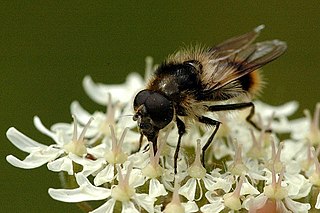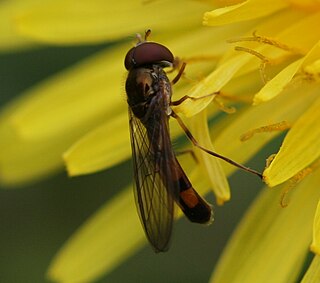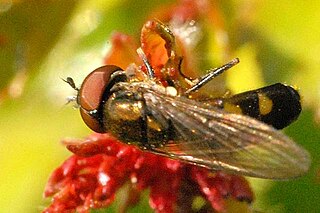
Hover flies, also called flower flies or syrphid flies, make up the insect family Syrphidae. As their common name suggests, they are often seen hovering or nectaring at flowers; the adults of many species feed mainly on nectar and pollen, while the larvae (maggots) eat a wide range of foods. In some species, the larvae are saprotrophs, eating decaying plant and animal matter in the soil or in ponds and streams. In other species, the larvae are insectivores and prey on aphids, thrips, and other plant-sucking insects.

Eristalinae are one of the four subfamilies of the fly family Syrphidae, or hoverflies. A well-known species included in this subfamily is the dronefly, Eristalis tenax.

Xylota segnis, The Brown-toed Forest Fly, is a common species of hoverfly.

Myathropa florea, sometimes referred to as the Batman hoverfly, is a very common European and North African species of hoverfly. Adults may be seen on flowers from May to September. It is of a similar size to the common drone fly, but Myathropa are generally more yellow, with two light bands to the thorax, interrupted with a black central smudge. In museum specimens, any yellow colour soon fades to brown after death. Like most species in the tribe Eristalini, Myathropa are rather variable in size, shape and colour.

Platycheirus clypeatus is a species of hoverfly. It is found across the Palearctic and in the Nearctic. The larvae feed on aphids. Adults are usually found on the edges of woodland or scrub, heath or along hedgerows where they visit a wide range of flowers.

Cheilosia illustrata is a species of hoverfly belonging to the family Syrphidae.

Melanostoma scalare, the chequered hoverfly, is a very common species of hoverfly.

Baccha elongata is a species of hoverfly in the genus Baccha.

Platycheirus manicatus is a species of hoverfly. It is found across the Palearctic and in Alaska.

Platycheirus splendidus is a species of hoverfly. It is found in many parts of Britain and Europe.

Lejogaster is a genus of small, shiny, metallic hoverflies.

Myolepta is a cosmopolitan genus of hoverflies most closely related to the genus Lepidomyia

These are small black and yellow or mostly black flies with a narrow abdomen near the thorax. They occur mainly in damp places among low herbage. The larva of Neosascia are flattened without oral hooks and a have a short posterior spiracular process or "tail" rat-tailed that is saprophagous. In 1925 Curran reviewed the genus Neoascia. In this work a key is provided and ten species are described including four new species some of which have later been determined to be synonyms.

The Brachyopini is a tribe of hoverflies. Unlike many members of this family these flies are generally darker and less colourful though some genera contain species with an attractive metallic lustre e.g. Chrysogaster. Some like Brachyopa are associated with sap runs where their larvae feed on decaying sap. Others are found in boggy areas where their often semiaquatic larvae feed on decaying organic matter.

Eristalini is a tribe of hoverflies. Several species are well-known honeybee mimics, such as the drone fly Eristalis tenax, while other genera such as Helophilus and Parhelophilus exhibit wasp-like patterns of yellow and black stripes, both strategies to avoid predation by visual predators such as birds.

Pipizini is a tribe of small to medium-sized generally black hoverflies, although some species also have orange spots on their abdomen. This nondescript colouring can lead to some species being confused with other dark hoverflies from other tribes. The lack of a facial knob is a good defining feature which separates them from most of these other hoverflies. As with other species in the subfamily Syrphinae the larvae feed on aphids though there seems to be a preference for wax-secreting aphids e.g. Pemphigidae.

Parhelophilus consimilis is a Palearctic hoverfly.

Platycheirus ambiguus is a small widespread species of hoverfly found across the Palearctic from Ireland to Japan. A spring species found in flight in April and May, it visits spring-flowering trees and shrubs; e.g., Prunus spinosa in deciduous woodland and scrub.

Eumerus funeralis or lesser bulb fly is a species of Hoverfly, from the family Syrphidae, in the order Diptera. E. funeralis appears in Peck (1988) as a synonym of E. strigatus (Fallen), but was reinstated as the correct name for tuberculatus Rondani, sensu auctorum by Speight et al. (1998).

The Spheginina is a subtribe of hoverflies.



















